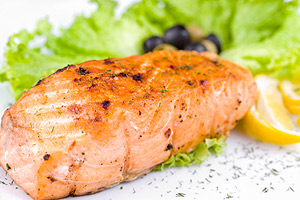 Wild Alaskan Salmon is one of the healthiest foods you can eat, and one of the main reasons is that it's full of a particular kind of fat that has more health benefits than almost any other single food on the planet. The type of fat in salmon belongs to a family called the omega-3s.
Wild Alaskan Salmon is one of the healthiest foods you can eat, and one of the main reasons is that it's full of a particular kind of fat that has more health benefits than almost any other single food on the planet. The type of fat in salmon belongs to a family called the omega-3s.
As we have previously discussed, omega-3s are helpful for heart health and brain health, as well as for inflammation, circulation, memory, thought, and blood sugar control. It is well documented that salmon is one of the best sources of these omega-3s on the planet.
So why buy salmon from the ocean vs. a salmon farm?
The omega-3 fats in salmon are “made” by the salmon just like every other fish or animal creates its tissues from the food it eats. Salmon are natural carnivores; they eat mackerel, sardines, krill, and other fish. When salmon consume their natural diet in the wild, the result is a fish filled with healthy omega-3 fats. So now you are probably wondering what kind of food farm-raised salmon eat, well if you've read my dairy section, you will find that grain might also be the culprit. So it makes sense that farm-raised salmon's diet has very little to do with what salmon eat in the wild and that they produce very little amount of omega-3 fats.
At salmon farms, thousands of salmon are crowded into small, roped off areas called “net pens” which result in serious health repercussions for both the fish and the surrounding waters. Not only are the fish packed liked sardines, disease can spread rapidly in these tight conditions, so farmed-fish receive tons of antibiotics, both in their feed and through injections. Grain again is not the natural diet of salmon any more than it is for cows and chickens. The end result is that the fat in farm salmon is completely different from the fat in wild salmon.
As a result of their grain diet, the fat of farm-raised salmon contain a much higher proportion of inflammatory omega-6s, a fat that we already consume far too much.

©2021 Kyle G. McCroskey. Website by Under Watercolours.